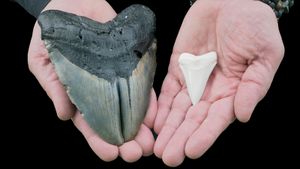Shark Anatomy
When people think of sharks, they generally imagine an animal like the one in this picture. The tall dorsal fin, torpedo-shaped body and giant teeth of this great white shark are familiar to most everybody. But there are actually more than 400 different shark species alive today, and they vary considerably in size and appearance. In fact, roughly 50 percent of shark species are less than a meter long. So what makes a shark a shark?
Sharks, along with rays and chimeras, are distinguished from other fish primarily by their body composition. Most other fish have skeletons made of bone, just like mammals, reptiles, amphibians and birds. Sharks and rays, on the other hand, have skeletons made entirely of cartilage, the same flexible material in your nose and ears. Cartilage is sturdy like bone, but it has a much lower density. This material keeps sharks relatively lightweight, so they don't sink in the ocean and they don't need an air bladder like other fish.
Advertisement
Sharks also have a very unique skin texture. They don't have the large, prominent scales found in bony fish. Instead they're covered with smaller, tooth-like scales called denticles. These tough, protective denticles are aligned so that they channel water over the shark's body, minimizing drag due to friction.
Like bony fish, sharks breathe by extracting dissolved oxygen from water. The water enters the mouth, passes through the gills and is expelled through gill slits behind the head. In bony fish, these slits are covered, but in most sharks you can see them clearly. As the water flows through the gill opening, it passes tiny gill filaments. These filaments are covered with microscopic blood vessel capillaries, which have a lower oxygen content than the water around them. This imbalance causes oxygen in the water to diffuse into the shark's bloodstream, where it is distributed throughout the body.
Some sharks have a gill pump, a set of muscles that suck in water and push it past the gills. This works something like our lungs -- the shark can continuously gather oxygen while it is in a still position. Most sharks also extract oxygen using ram ventilation, passing water over the gills by moving forward. Some highly-active sharks depend on ram ventilation almost entirely, which means they stay in motion most of the time!
Sharks also differ from most bony fish in the way they move. In the next section, we'll find out how sharks swim so quickly and gracefully through the ocean.











